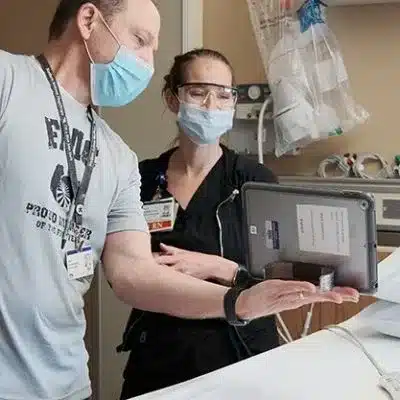Most days, an iPad is just an iPad. But as healthcare, technology and human innovation quickly evolve at Northern Arizona Healthcare, an iPad is a lifeline.
Early on in the COVID-19 pandemic, as Flagstaff Medical Center began to halt visitation for health and safety reasons, nurses and senior leaders knew it was important to find a way to help families communicate with their loved ones in the hospital.
“We had never closed the doors to families before,” said Tyffany Laurano, Northern Arizona Healthcare’s chief nursing officer. “That is hugely impactful…being able to talk to and connect with your family during a hospitalization makes all the difference to how well and how fast a patient will heal and how receptive they’ll be to their plan of care.”
As they discussed the issue, Laurano and other healthcare providers and leaders remembered: there were 100 iPads available in the Education department.
“It was suggested at that time that we try to use those iPads to allow for families to Zoom with their loved ones. And knowing (Audiovisual Manager) Mike Mills, I very quickly recognized that he would be our best asset to be able to make this happen,” Laurano said.
Mills met the challenge head-on, spearheading a campaign to disseminate the iPads to charge nurses on each floor and ensuring they knew how to use the technology and keep the devices sanitary. Never before had he been so directly involved with patient care, but he used his knowledge base to make amazing connections happen.
“I think with my AV team, we often talk about how we don’t have direct patient care, but what we do supports that care,” he said. “Even though we don’t see those patients, it directly impacts decisions that the organization is making in terms of how best to care for them,” he said. “Even when folks are in a coma, or unconscious…their hearing is still intact and they can hear voices; conversations around them – so it was very, very powerful.
“I absolutely brought new life into what I do,” he said.
Stacey Payne, ICU and surgical trauma educator at FMC, emphasized that no COVID-19 patient had to suffer through their illness alone – whether they used iPads or not.
“Nurses are there,” she said. “We are holding their hands and rubbing their heads. Having their family members on Zoom is no substitute for their presence at the bedside, but we were able to provide that human connection for them.”
Sometimes nurses set the iPads up while patients are sleeping so their families can say a prayer, sing a song or just keep an eye on them as they heal.
“What has really, really shined is the innovation of our nurses,” said Payne. “Nurses are trained to be critical thinkers and to kind of think outside the box. Our nurses were doing this with their own cell phones before the iPads got up and running.”
FMC nurse Sarah Kahn remembers the first patient she cared for who was able to be off a ventilator long enough to call his family. The man was too weak to speak or even lift his arms, but he could mouth words and be understood. This was a powerful sign that he was on the road to recovery and winning his battle against COVID-19. Kahn set up the iPad so the patient could speak with his wife, daughter and two grandchildren.
“It was Easter Sunday and the family was elated, talking and singing to him for almost an hour,” Kahn said. “They sang him song after song and he mouthed the words to ‘Amazing Grace’ along with them. All the while, sweating inside my hot Tyvek suit, tears streaming down my face that I was unable to wipe away under my CAPR shield, I watched.
“It was the first time I was able to tell a wife her husband was improving, it was the first time a family was able to realistically expect that their dad would be home soon, it was the first time I knew one of my patients would survive, and I was filled with hope for this man and his family.”
